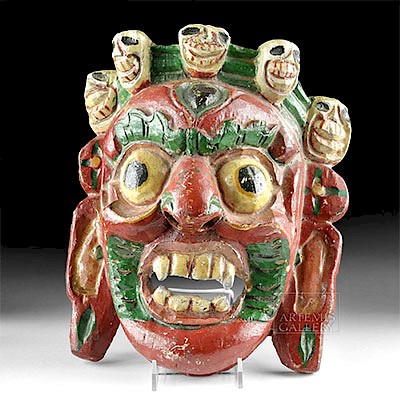Costa Rican Polychrome Vessel w/ Kukulkan & TL Test
Lot 82f
About Seller
Artemis Fine Arts
686 S Taylor Ave, Ste 106
Louisville, CO 80027
United States
Selling antiquities, ancient and ethnographic art online since 1993, Artemis Gallery specializes in Classical Antiquities (Egyptian, Greek, Roman, Near Eastern), Asian, Pre-Columbian, African / Tribal / Oceanographic art. Our extensive inventory includes pottery, stone, metal, wood, glass and textil...Read more
Estimate:
$2,200 - $2,800
Absentee vs Live bid
Two ways to bid:
- Leave a max absentee bid and the platform will bid on your behalf up to your maximum bid during the live auction.
- Bid live during the auction and your bids will be submitted real-time to the auctioneer.
Bid Increments
| Price | Bid Increment |
|---|---|
| $0 | $25 |
| $300 | $50 |
| $1,000 | $100 |
| $2,000 | $250 |
| $5,000 | $500 |
| $10,000 | $1,000 |
| $20,000 | $2,500 |
| $50,000 | $5,000 |
| $100,000 | $10,000 |
| $200,000 | $20,000 |
About Auction
By Artemis Fine Arts
Apr 25, 2019
Set Reminder
2019-04-25 10:00:00
2019-04-25 10:00:00
America/New_York
Bidsquare
Bidsquare : Pre-Columbian | Tribal | Ethnographic
https://www.bidsquare.com/auctions/artemis-gallery/pre-columbian-tribal-ethnographic-4035
Featuring ancient and ethnographic art from around the world, including Pre-Columbian, Native American, African / Tribal, Ethnographic, Spanish Colonial, Fossils, Fine Art, much more. Artemis Fine Arts info@artemisfinearts.com
Featuring ancient and ethnographic art from around the world, including Pre-Columbian, Native American, African / Tribal, Ethnographic, Spanish Colonial, Fossils, Fine Art, much more. Artemis Fine Arts info@artemisfinearts.com
- Lot Description
Pre-Columbian, Central America, Costa Rica, Greater Nicoya, Papagayo Polychrome variety, Phase VI, ca. 1000 to 1300 CE. A fabulous hand-built, egg-shaped, footed pottery vessel with an intricately decorated surface presenting two mesmerizing mythical creatures - perhaps variants of Kukulkan/Quetzalcoatl - on opposite walls painted in orange, red, and black hues atop a cream ground. Kukulkan, the Maya version of Quetzalcoatl, was a powerful "feathered serpent" venerated throughout ancient Mesoamerica. The ancients of Costa Rica traded with the Maya and perhaps saw imagery of this magical creature during their exchanges. Each creature has feathered wings and breastplates, a tall feathered crown and tail cap, and a gaping maw emanating a sinuous tongue beneath a curled, upturned snout. Above both creatures are concentric registers of abstract red and orange serpentine forms, and the rim and foot are adorned with solid swaths of red-orange pigment. An exquisite example with a well-preserved iconographic program. Size: 6.625" W x 9.8" H (16.8 cm x 24.9 cm).
Quetzalcoatl or Kukulcan was a powerful god among the indigenous of the Americas. Kukulkan's meaning to the Maya world is not fully understood, but we know that for the Aztecs, the same figure is associated with the wind, the creation of arts and crafts, and knowledge. In addition, a serpent is sometimes used in Mayan iconography as the embodiment of the sky itself. According to the pioneering Mexican artist/anthropologist Miguel Covarrubias, whose classic tomes and illustrations continue to contribute to scholarly studies today, "Quetzalcoatl stood for all that was good in this world: peace, art, wisdom, and prosperity. Disguised as an ant, he discovered maize, the staple food of the Indians, hidden under the mountain of Substance, Tonacatepetl; he also invented the arts, the sciences, and the calendar. In fact, everything connected with wisdom and culture was attributed to Quetzalcoatl." (Covarrubias, Miguel. "Mexico South: The Isthmus of Tehuantepec." Alfred A. Knopf, New York, 1946, p. 130)
This piece has been tested using thermoluminescence (TL) analysis and has been found to be ancient and of the period stated. A full report will accompany purchase.
Provenance: ex-private New York, New York, USA collection; ex-William and Carol Thibadeau, Sr. collection, acquired in the 1970s to 1980s; ex-Tom Francis collection, Gainesville, Georgia, USA, acquired via descent to family, collection # AA125
All items legal to buy/sell under U.S. Statute covering cultural patrimony Code 2600, CHAPTER 14, and are guaranteed to be as described or your money back.
A Certificate of Authenticity will accompany all winning bids.
We ship worldwide and handle all shipping in-house for your convenience.
#145130Minor nicks and abrasions to rim, body, and foot, with light fading and areas of darkening to original pigmentation, and light encrustations, otherwise intact and excellent. Light earthen deposits and fine craquelure to pigmentation throughout. Old inventory labels beneath foot.Condition
- Shipping Info
-
All shipping is handled in-house for your convenience. Your invoice from Artemis Gallery will include shipping calculation instructions. If in doubt, please inquire BEFORE bidding for estimated shipping costs for individual items.
-
- Buyer's Premium



 EUR
EUR CAD
CAD AUD
AUD GBP
GBP MXN
MXN HKD
HKD CNY
CNY MYR
MYR SEK
SEK SGD
SGD CHF
CHF THB
THB
















